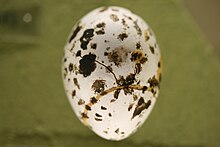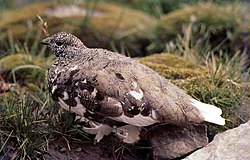Lagopus
| Lagopus Temporal range: Early Pliocene to present
| |
|---|---|

| |
| Willow ptarmigan (L. lagopus) | |
| Scientific classification | |
| Domain: | Eukaryota |
| Kingdom: | Animalia |
| Phylum: | Chordata |
| Class: | Aves |
| Order: | Galliformes |
| Family: | Phasianidae |
| Tribe: | Tetraonini |
| Genus: | Lagopus Brisson, 1760 |
| Type species | |
| Tetrao lagopus Linnaeus, 1758
| |
| Species | |
|
See text | |
Lagopus is a small genus of birds in the grouse subfamily commonly known as ptarmigans (/ˈtɑːrmɪɡənz/). The genus contains three living species with numerous described subspecies, all living in tundra or cold upland areas.
Taxonomy and etymology
The genus Lagopus was introduced by the French zoologist Mathurin Jacques Brisson in 1760 with the willow ptarmigan (Lagopus lagopus) as the type species.[1][2] The genus name Lagopus is derived from Ancient Greek lagos (λαγος), meaning "hare", + pous (πους), "foot", in reference to the feathered feet and toes typical of this cold-adapted group (such as the snowshoe hare). The specific epithets muta and leucura were for a long time misspelt mutus and leucurus, in the erroneous belief that the ending of Lagopus denotes masculine gender. However, as the Ancient Greek term λαγωπους is of feminine gender, and the specific epithet has to agree with that, the feminine muta and leucura are correct.[3]
The English name ptarmigan comes from the Scottish Gaelic name for the bird, tàrmachan, whose origin is unknown. The p- was added due to a mistaken belief in a Greek origin, as if the word were related to the Greek word πτερόν (pterón), 'wing'.
Description

The three species are all sedentary specialists of cold regions. Willow ptarmigan is a circumpolar boreal forest species, white-tailed ptarmigan is a North American alpine bird, and rock ptarmigan breeds in both Arctic and mountain habitats across Eurasia and North America. With the exception of the red grouse, all have a white winter plumage that helps them blend into the snowy background. Even their remiges are white, while these feathers are black in almost all birds (even birds that are predominantly white, such as the Bali myna) because melanin makes them more resilient and thus improves flight performance. The Lagopus grouse apparently found it easier to escape predators by not being seen than by flying away.[citation needed]
These are hardy vegetarian birds, but insects are also taken by the developing young. In all species except for the willow ptarmigan, the female takes all responsibility for nesting and caring for the chicks, as is typical with gamebirds.
Species
The genus contains three species:[4]
| Living species of Lagopus | |||
|---|---|---|---|
| Common and scientific names | Image | Description | Range and status |
| Willow ptarmigan (also willow grouse and red grouse) Lagopus lagopus Linnaeus, 1758 |
 |
Summer: marbled brown and reddish with black tail and white underparts; winter: most subspecies have white plumage except for black tail. | 10-20 subspecies. Circumarctic range in forest and moorlands of northern Eurasia and North America. Status: Least Concern. |
| Rock ptarmigan Lagopus muta Montin, 1781 |
 |
Summer: grey and brown upperparts; winter: white plumage. Distinguish from willow ptarmigan by habitat – higher elevations and more barren ground. | 20-30 subspecies. Arctic and subarctic Eurasia and North America on rocky mountainsides and tundra. Status: Least Concern. |
| White-tailed ptarmigan Lagopus leucura Richardson, 1831 |
 |
Summer: greyish-brown and speckled; winter: white plumage. Males identifiable by reddish eyecombs. The smallest ptarmigan. | Alpine areas above the timberline in North America from Alaska and western Canada to New Mexico. Status: Least Concern. |

The distinctive British form of willow ptarmigan, the red grouse (Lagopus lagopus scotica) has sometimes been considered a separate species, L. scotica, but this is no longer accepted.
Fossil record
Two prehistoric species and two paleosubspecies are only known from fossils:
- Lagopus atavus (Early Pliocene of Bulgaria? - Late Pliocene)
- Lagopus balcanicus (Late Pliocene of Varshets, Bulgaria)[5]
- Lagopus lagopus noaillensis (Pleistocene of W Europe)
- Lagopus mutus correzensis (Pleistocene of W Europe)
References
- ^ Brisson, Mathurin Jacques (1760). Ornithologie, ou, Méthode Contenant la Division des Oiseaux en Ordres, Sections, Genres, Especes & leurs Variétés (in French and Latin). Paris: Jean-Baptiste Bauche. Vol. 1, p. 26, Vol. 1, p. 181.
- ^ Peters, James Lee, ed. (1934). Check-list of Birds of the World. Vol. Volume 2. Cambridge, Massachusetts: Harvard University Press. p. 29.
{{cite book}}:|volume=has extra text (help) - ^ David, Normand; Gosselin, Michel (2002). "The grammatical gender of avian genera". Bulletin of the British Ornithologists' Club. 122 (4): 257-282 [258, 279].
- ^ Gill, Frank; Donsker, David, eds. (2019). "Pheasants, partridges, francolins". World Bird List Version 9.1. International Ornithologists' Union. Retrieved 3 April 2019.
- ^ Boev, Z. 1995. Middle Villafranchian birds from Varshets (Western Balkan Range - Bulgaria). - In: Peters, D. (ed.). Acta palaeornithologica. 3. Symposium SAPE. 5. Internat. Senckenberg-Konferenz 22-26 Juni 1992. - Courier Forschungsinstitut Senckenberg. Frankfurt a. M., 181: 259-269.
- Madge, Steve; McGowan, Philip J. K. & Kirwan, Guy M. (2002): Pheasants, partidges and grouse : a guide to the pheasants, partridges, quails, grouse, guineafowl, buttonquails and sandgrouse of the world. Christopher Helm, London. ISBN 0-7136-3966-0
